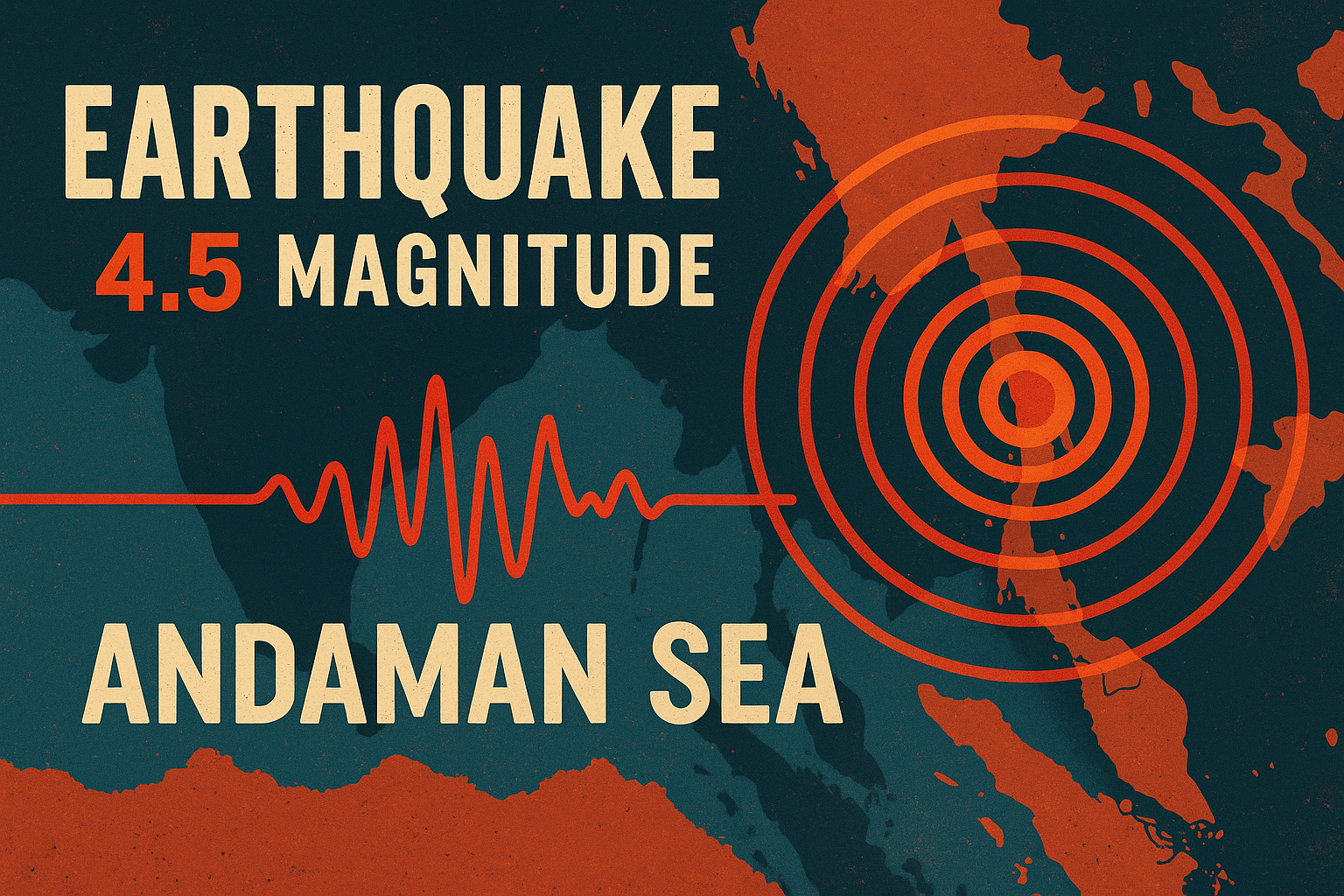On July 6, 2025, early in the morning, the Andaman Sea Shaken by 4.5 Magnitude Earthquake rattled coastal and nearby regions, drawing attention to the seismic activity in this geologically volatile hotspot. The National Centre for Seismology (NCS) confirmed the event, stating the earthquake struck at 07:03:34 IST, with a magnitude of 4.5, at a shallow depth of 10 km. Its epicentre was located at approximately 6.60°N, 95.05°Evolcanodiscovery.com+9livemint.com+9thenewsmill.com+9.
https://indialolnews.com/southwestern-japan-shaken-by-5-5/This article unpacks the implications of the Andaman Sea Shaken by 4.5 Magnitude Earthquake, diving into its geologic causes, recent patterns, safety implications, and what residents should do now.
📍 Earthquake Details & Location
- Magnitude: 4.5
- Date & Time: July 6, 2025, at 07:03:34 IST
- Epicentre: 6.60°N, 95.05°E, in the Andaman Sea
- Depth: 10 km (relatively shallow) thenewsmill.com+3livemint.com+3nationthailand.com+3
The seismic tremor woke up nearby residents and fishing communities. Due to its moderate magnitude and shallow depth, the quake was felt but did not cause major damage or trigger tsunamis. Authorities have confirmed that Andaman Sea Shaken by 4.5 Magnitude Earthquake posed no immediate dangers beyond mild shaking.
Why the Andaman Sea Is So Seismically Active
The Andaman Sea Shaken by 4.5 Magnitude Earthquake underscores the region’s intense geological dynamism, shaped by the convergence of the Burma Plate and the Sunda Plate, and influenced by the West Andaman Fault zone. These tectonic boundaries contribute to frequent seismic activity in this back‑arc basinen.wikipedia.org+2en.wikipedia.org+2en.wikipedia.org+2.
Just recently, from June 24 to July 4, a swarm of over 114 small-to-moderate quakes (magnitudes 3.4–4.9) struck near the Nicobar Islands—none triggering tsunamis, as they were primarily strike-slip movements along horizontal faultsnationthailand.com+1nationthailand.com+1. The Andaman Sea Shaken by 4.5 Magnitude Earthquake fits within the region’s normal activity patterns.
Recent Seismic Swarm: A Pattern of Activity
The Andaman Sea Shaken by 4.5 Magnitude Earthquake aligns with a broader seismic swarm in late June and early July. Notably:
- On June 30, three quakes struck: 4.6 and 4.7 magnitudes in quick succession.
- Earlier, on June 25, a 4.2 magnitude quake shook the same zone.
- The latest ≤4.7 events were shallow (10 km depth) near the Nicobarsen.wikipedia.org+10livemint.com+10thenewsmill.com+10.
Seismic swarms like these often occur in active rift zones but typically pose limited risk. Still, the Andaman Sea Shaken by 4.5 Magnitude Earthquake serves as a reminder for preparedness.
Tsunami Risk & Safety Protocols
Despite its magnitude, the Andaman Sea Shaken by 4.5 Magnitude Earthquake didn’t trigger a tsunami alert. According to Thailand’s meteorological department, shallow, strike-slip quakes like these do not displace enough water to generate tsunamis. Similar conclusions apply here.
However, historical events—like the massive 2004 Sumatra–Andaman earthquake (magnitude 9.2–9.3)—show what’s possible when tectonic slippage is verticalen.wikipedia.orgnationthailand.com+7en.wikipedia.org+7nationthailand.com+7. This time, the quake posed no tsunami threat, but awareness remains key.
What Residents and Fisherfolk Should Do
Even moderate quakes demand precaution. Here’s what to do after Andaman Sea Shaken by 4.5 Magnitude Earthquake:
For Coastal Communities:
- Immediately move to higher ground until shore movement stops.
- Avoid standing near cliffs or shorelines for some time.
For Offshore Workers and Boat Operators:
- Secure vessels and ensure navigation safety.
- Monitor radio and emergency channels for alerts.
General Safety Tips:
- Drop, cover, and hold on indoors.
- Check your home for minor damage and inspect gas lines or water systems.
- Stay tuned to local authorities and mobile alert systems.
Science Behind the Tremor
Over time, tectonic pressures build at plate boundaries. In this region, the interplay of strike-slip stress along the West Andaman Fault and subduction along the Sunda trench often manifests in shallow quakes—the typical pattern seen in the Andaman Sea Shaken by 4.5 Magnitude Earthquakenationthailand.comvolcanodiscovery.com+5livemint.com+5thenewsmill.com+5.
Earthquake track data reinforces this: many past quakes in the area—like the January 20 and March 24, 2025 events—are consistent in magnitude and depth (4.5–5.0 at ~10 km). Thus, while notable, this quake reflects a continuing geological process.
Historical Context: A Seismic Legacy
The Andaman Sea Shaken by 4.5 Magnitude Earthquake is moderate compared to historic events. Since the deadly 2004 tsunami, the region has remained seismically vigilant. Earlier megaquakes include:
- 2004: 9.2–9.3 magnitude, massive tsunami triggered
- 2009: Magnitude 7.5 quake, led to tsunami watch but no damageen.wikipedia.org
- 1881: Magnitude 7.9 quake near Nicobars, minor tsunamien.wikipedia.org+1nationthailand.com+1
By comparison, the Andaman Sea Shaken by 4.5 Magnitude Earthquake was modest and within expected seismic behavior.
Monitoring and Preparedness Going Forward
Geologists and monitoring agencies are continuing to track seismicity. With quake swarms and fault tension patterns, residents in Andaman & Nicobar must keep alerts, drills, and evacuation plans active. The Andaman Sea Shaken by 4.5 Magnitude Earthquake should reinforce, not alarm.
Local authorities recommend:
- Keeping mobile alerts enabled
- Preparing emergency kits
- Knowing evacuation routes
- Conducting community drills
Public awareness will remain central in reducing risk from future tremors.
Final Thoughts
Though the Andaman Sea Shaken by 4.5 Magnitude Earthquake didn’t cause significant damage or tsunamis, it acts as a crucial signal of the region’s ongoing tectonic processes. With the convergence of the Burma and Sunda plates and the active West Andaman Fault, the Andaman Sea remains a seismic hotspot.
Residents and mariners are urged to stay informed, heed alerts, and practise earthquake safety consistently. This quake serves as a timely reminder: even moderate earthquakes deserve attention.
Summary
- Magnitude 4.5 quake struck the Andaman Sea on July 6, 2025 at 07:03 IST.
- Epicentre at 6.60°N, 95.05°E; depth 10 km — confirmed by NCSnationthailand.com+7livemint.com+7thenewsmill.com+7en.wikipedia.org+1en.wikipedia.org+1.
- Located in a high-risk seismic zone due to tectonic plate boundaries.
- Part of a recent seismic swarm in the Nicobars — no tsunami threatnationthailand.com+1nationthailand.com+1.
- Safety precautions for residents and fishermen recommended.
- Historical context shows potential for much larger quakes; preparedness is key.
Stay informed and stay safe. Follow future alerts if the Andaman Sea Shaken by 4.5 Magnitude Earthquake continues to exhibit seismic activity.
